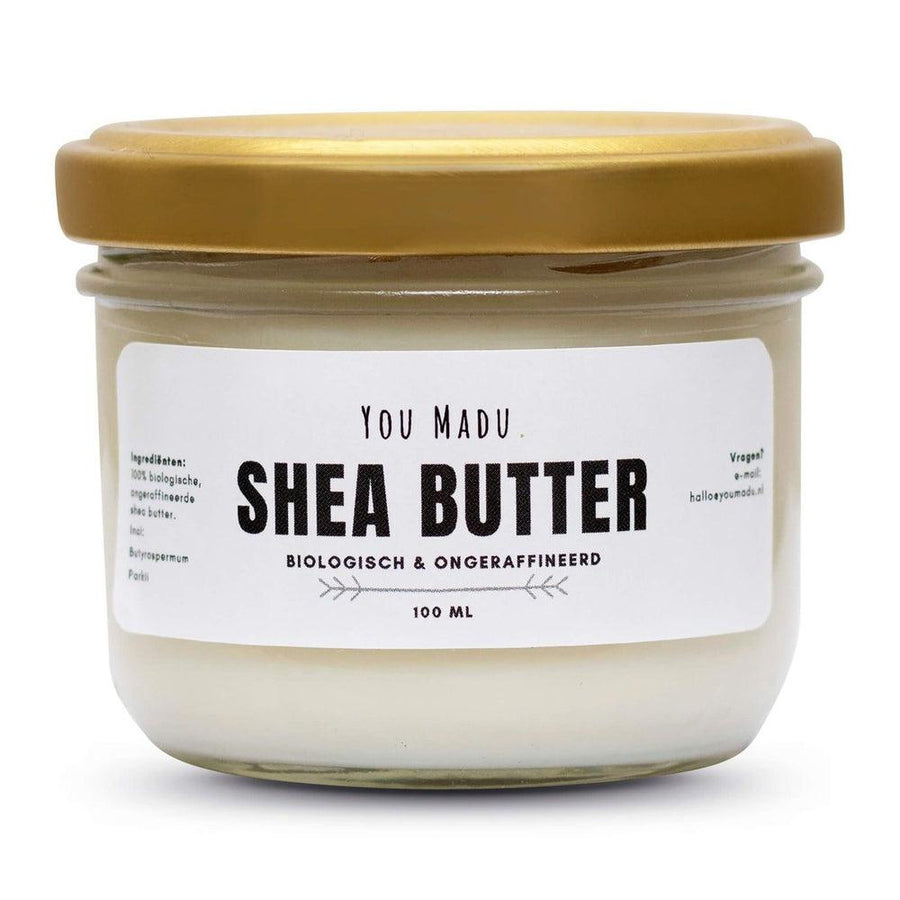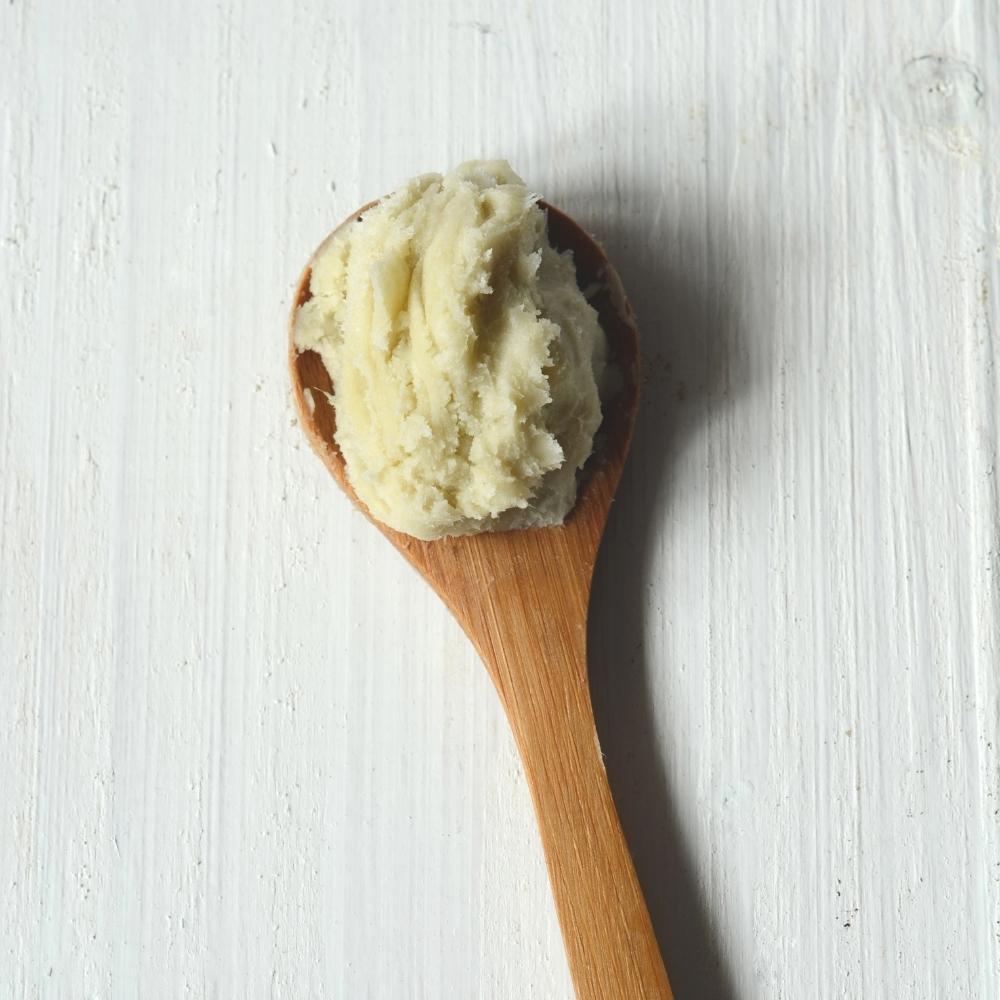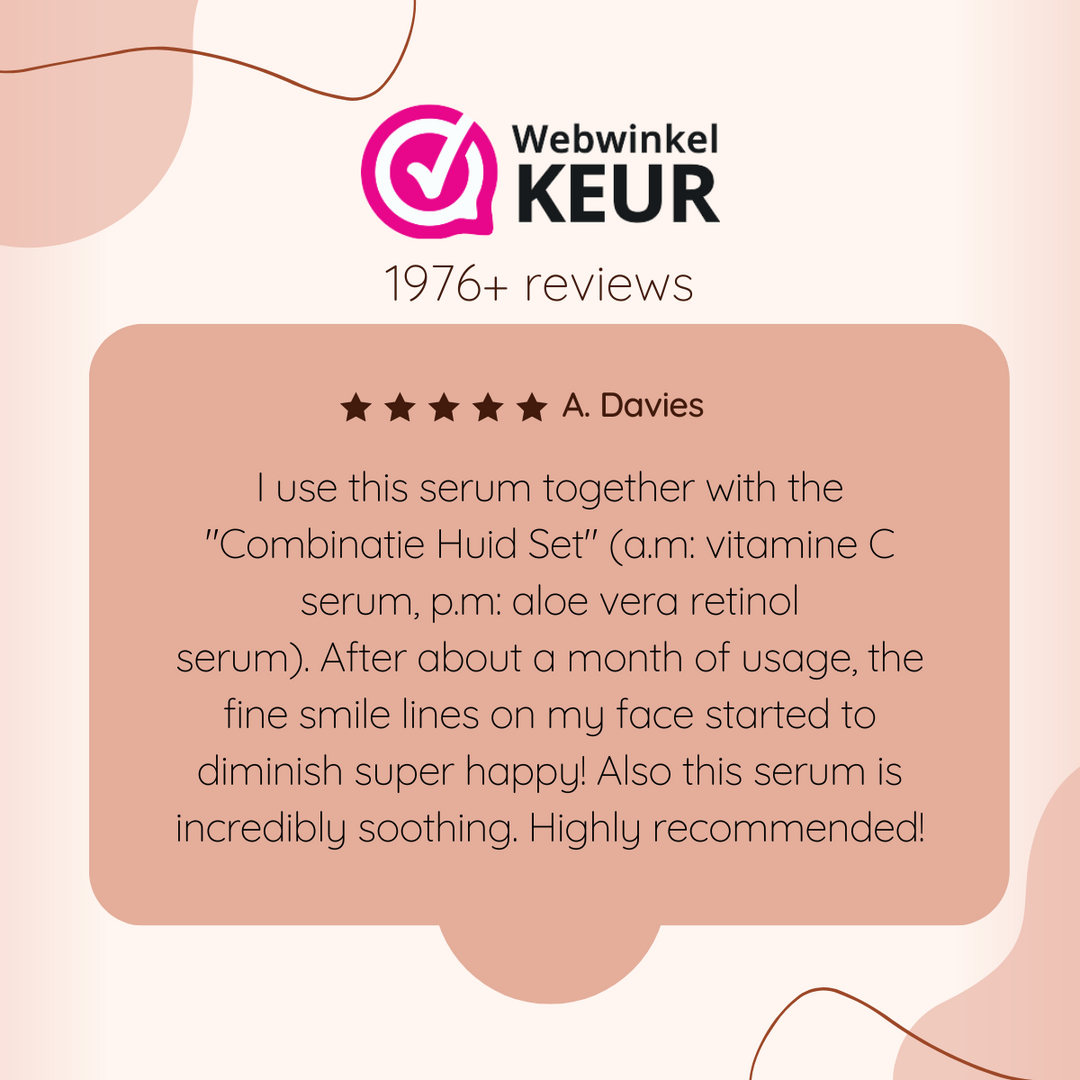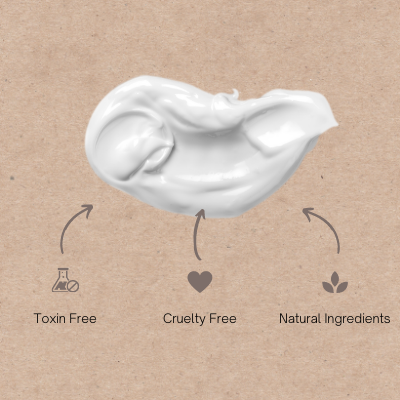What is Shea Butter? Frequently Asked Questions

Shea butter, also known as shea butter or shea butter, is a fantastic natural moisturizing oil/cream.
At room temperature shea butter is quite thick, but when you rub it in your hands it melts and moisturizes your skin deeply. Shea butter is fantastic as an eye cream, lip balm or in your homemade body butter to revitalize dry skin.
Shea butter contains fatty acids that have an anti-inflammatory and anti-aging effect on your skin. It also nourishes dry skin with essential fatty acids and the nutrients that help your skin produce collagen. Using shea on the skin can also provide light UV protection.
Table of Contents
- What is Shea Butter / Shea Butter?
- Shea Butter Benefits
- How is Shea Butter made?
- How to use Shea Butter?
- Which Shea Butter should I buy?
- What is the difference between grade A,B,C,D and E shea butter?
- For which skin problems can you use shea?
- How do I use shea butter on my face?
- How long can you store shea butter?
- Can I eat shea butter?
- Shea Butter Side Effects
- Does shea butter clog your pores?
- How do I make whipped shea butter?
- Where can you buy shea butter?
What is Shea Butter / Shea Butter?
Shea butter (also called shea butter) is a natural oil/butter made from the seeds of the fruit of the shea tree.
Shea trees come from the African Savannah and most shea butter is still made in that region.
Shea butter has long been used in West and East Africa to moisturize and protect the skin and hair. It also has a long history of medicinal use, in wound care and the treatment of leprosy.Even the Egyptian Queen Cleopatra would have used it as a personal care product.
In Africa it is sometimes also used in food. Whether this is healthy, opinions are somewhat divided. There are studies showing that consuming shea butter can interfere with protein digestion, but more research is needed to get a clear picture of this.
The botanical name of the Shea tree that you mainly find in Gana is Vitellaria Paradoxa (formerly called butyrospermum parkii).There is yet another type of Shea tree that can be found in Nigeria and the surrounding area, the Vitellaria Nilotica. The so-called Shea Nilotica butter is made from the nuts of this type of Shea tree.

3 Shea Butter Benefits
1. Hydrates your skin
Shea butter contains a large amount of vitamins such as vitamin E and vitamin A, as well as fatty acids that nourish and moisturize your skin. It is a fantastic product to prevent and treat dry skin and protect your skin.
2. Anti-inflammatory
Research has shown that shea butter has an anti-inflammatory effect that can even help people with acne.
3. Anti aging
Using shea butter boosts your skin's collagen production.
In addition, the butter also contains stearic acid, linolenic acid, palmitic acid. These fatty acids nourish and protect the skin, which helps prevent the skin from drying out. This can also help reduce wrinkles and lighten blemishes on the skin.
How is Shea Butter made?
Shea Butter is made from the seeds/nuts of the shea tree. If you are thinking of planting a shea tree yourself and making your own shea butter, you should start as soon as possible. It takes 20 years before the tree starts to grow its first fruits and it only reaches its peak after 45 years. You will enjoy it for a long time since the tree can produce fruit for up to 200 years.
The production process of Shea Butter is quite labor intensive:
- First the nuts of the shea tree are collected, which naturally fall from the shea tree.
- These are then blanched to remove the outer layer.
- They are then dried, coarsely ground and then roasted. After roasting, they are very finely ground into a dark brown paste.
- This paste is then kneaded by hand for hours. Then the paste is cleaned by rinsing it with water.Then the paste is heated over a low heat until the shea butter floats to the top.
- The shea butter is then allowed to cool until a beige colored cream is obtained.

How to Use Shea Butter
Shea butter is a very versatile skin care ingredient and is often used in products such as lip balm. You can use it 100% pure as a moisturizer, or use it in homemade beauty products. You can use it to make a body butter, a DIY lip balm, lotion bars, etc.
Here are some of our favorite uses for shea butter:
- Sheer on your face and body as moisturizing cream
- In a shea butter lotion bar for easy use
- As a mild aftersun lotion, pure or together with aloe vera juice, rosehip oil, almond oil and lavender oil
- Make your own pregnancy cream to prevent stretch marks with shea butter, beeswax, coconut oil, avocado oil and almond oil
- As an eye ointment to reduce crow's feet and puffiness
- If massage oil
- On your dry nose with a cold or flu
- On scars to fade them naturally
- As a basis for your DIY deodorant
- Directly on your lips or in a homemade lip balm
- On the eyelids before applying make-up
- As hair mask (in combination with other natural ingredients such as castor oil and jojoba oil)
TIP: If your shea butter is too thick to mix with other ingredients, melt it over very low heat. However, make sure you don't let it get too hot because then it loses some of its good properties.

Which Shea Butter Do I Buy Best?
Unrefined Shea Butter
Unrefined Shea Butter is made without the use of chemicals or high temperatures. As a result, the shea butter retains its moisturizing vitamins and fatty acids much better. Unrefined Shea Butter usually has a beige / pale yellow color and a slight earthy scent.
If you find that smell a bit strong, we recommend mixing your shea butter with your favorite essential oil.
Refined Shea Butter
High temperatures and sometimes chemicals are used to make refined shea butter. This gives you a very white shea paste, but the shea butter loses some of its vitamins and moisturizing fatty acids. The refined shea butter also has no odor.
According to some studies, shea loses as much as 75% of its bioactive ingredients during refining.
We currently only sell unrefined organic Shea Butter because it is so much better for your skin.
What is the Difference Between Grades A,B,C,D and E Shea Butter?
Shea butter is often also subdivided into different grades that indicate the quality and way in which it has been processed.
Grade A: This shea butter is "raw" and unrefined, and is not processed with chemicals.
Grade B: This shea butter is refined.
Grade C: This shea butter is refined and to extract the oil/butter from the nuts, chemical solvents such as hexane are used
Grade D: This shea contains many impurities and is the lowest grade not considered "contaminated".
Grade E: This shea is tainted/contaminated.
We always recommend using Grade A, or if you really don't like the smell of shea, Grade B because refining removes a lot of the smell, but also a lot of the vitamins.
For which skin problems can you use Shea?
When combating skin problems such as eczema and acne, it is often a search for products that work for your skin. Every skin is different and there are many factors that cause such skin problems, such as the food you eat, your sleeping pattern, air pollution, etc.
Shea butter of emollient and healing properties at:
- Eczema
- Stretch marks on the skin
- Problems with dry skin and/or hair
- Dermatitis
- Psoriasis
- Fine lines and wrinkles
- Oily skin and acne
- Cracked skin and fissures
- Itchy skin
- Muscle fatigue and stiff muscles
- Sunburn
- Skin allergies and rashes
- Scars and dark spots
How do I use Shea Butter on my face?
You can simply use shea pure on your face as a moisturizing cream by rubbing a little in your hand and then applying it to your face. The shea melts away and is absorbed by your facial skin. You can do this in the evening before going to sleep, since shea is relatively greasy and your skin will have a shiny layer for a while.
If you use it in the morning, make sure you don't use too much so that it absorbs quickly into your skin. If there is still some left on top of your skin after applying it properly, you can remove it with a cloth.
Another great way to use shea butter is if you melt it and then mix it with a moisturizing oil like e.g. argan oil, rosehip oil or almond oil. A 50/50 ratio of shea and oil works well. Optionally, you can also add 1 or more essential oils for a nice scent and additional therapeutic effect of that oil.
How long can you store Shea Butter?
If kept in a cool and dark place, you can keep it up to 3-4 years after production.
Under certain circumstances things can get bad sooner:
- Due to oxidation. Light and heat can change the chemical structure of the shea butter, which can make it smell rancid and sour.
- Due to contamination with water. Because no preservatives are used in unrefined shea butter, mold can begin to grow in the shea if it is exposed to water for an extended period of time.
Can I eat Shea Butter?
As mentioned earlier, there are African tribes that use Shea Butter in the kitchen. Currently (as far as we know) shea is not tested/certified for use as food anywhere outside Africa, but this could change in the future.
Shea Butter Side Effects
While shea butter is generally safe to use, people with nut allergies should exercise caution. There is a possibility of experiencing adverse reactions since shea butter comes from the nuts of the shea tree.
Topical allergies to shea butter are rare, but can occur. It is best to always do a patch test where you apply a small amount to a small area of skin and wait 24 hours to see if there is a reaction. If your skin reacts badly, stop using the product.
Does Shea Butter Clog Your Pores?
Some people claim shea butter clogs pores, while others say it doesn't.
Shea butter has not been studied enough scientifically to know for sure whether it is comedogenic or not. Therefore, it is not officially categorized. However, we can look at the composition of shea butter to get some ideas.
Shea butter is generally considered to have a score between 0 and 2 out of 5, where 0 means it doesn't block pores and 2 means the probability is moderately low. But again, this has not been proven.
How do I make Whipped Shea butter?
Because shea butter can be quite a solid substance, especially in winter, some users whip up the shea to make it easier to spread. By beating air into the shea butter it becomes light and fluffy, making it slightly easier to use.
This is how you do that:
- Melt the shea butter slowly over low heat in a bain-marie.
- Once it has melted, turn off the heat, and optionally add a carrier oil such as argan oil or sweet almond oil (this makes the end result lighter) and vitamin E oil (this helps it to last longer).
- Let it cool to room temperature
- Stir occasionally while it cools to about 20 - 25 degrees Celsius
- Now you can optionally add essential oils
- Whip it for a few minutes while it is still liquid
- Put in the refrigerator until the mixture hardens
- Then take it out of the fridge and let it come back to room temperature
- Now beat the mixture again until you get a "fluffly" butter/substance
- Done! Store your whipped shea in a jar or bag, and smear
Where can you buy Shea Butter?
You can here purchase unrefined and organic Shea Butter of the highest quality in a durable glass jar.
Our Shea Butter comes from Ghana where we work together with a small producer who receives Fair Trade wages and produces the Shea Butter in a traditional way.


